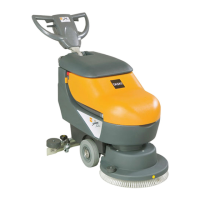Technical Manual
31. May 2007 Revision: V1.10 2-2
Copyright © 2007, JohnsonDiversey, Inc.
04.0 swingo 450B - elementary.fm - 31. May 2007
2Elementary
2.1 Health & Safety
Scrubber dryers may be powered by mains electricity or batteries. There are risks as-
sociated with both, which call for proper precautions, such as the provision of good
ventilation and the elimination of risk of ignition.
All work, implemented on such machines should only be performed by trained per-
sonnel in accordance with local regulations.
Before working on such a machine, isolate it from any electrical source and lock out
/ tagout.
Always wear the required Personal Protective Equipment (including gloves and gog-
gles that must be worn when potentially exposed to any hazardous material and when
carrying out hazardous work tasks).
Note that parts may be contaminated with chemical product. If possible flush hoses
out with fresh water prior to carrying out any maintenance. For information on chem-
ical products that are used in this machine, please carefully read the product label
and Material Safety Data Sheet (MSDS).
Empty water tanks prior to carrying out any maintenance. Ensure contaminated water
is emtied into an approved drain. Avoid pollution.
2.2 ESD
STATIC ELECTRICITY is electricity at rest or the accumulation of electric charge, as
opposed to an electric current which is the movement of electricity. The flow or move-
ment of people and/or materials in and through the environment causes separation
and therefore static electricity. A familiar example of static electricity is when a per-
son walks across a carpeted floor. Static electricity/electrostatic charge is generated
simply by the contact and separation of the soles of that individual's shoes from the
carpeted floor
ELECTROSTATIC DISCHARGE (ESD) occurs when the electrostatic charge is trans-
ferred from a material that carries the charge to an electrostatic sensitive device. In
the example above, this electrostatic discharge is the "shock" felt after walking across
the carpeted floor and then touching a door knob. It is this electrostatic discharge,
which comes in varying degrees, that can be most damaging to electrical devices and

